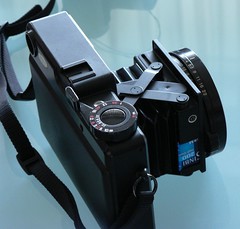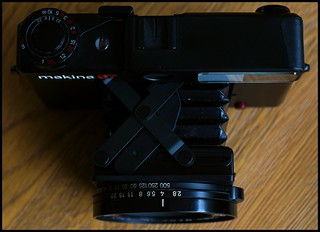Difference between revisions of "Makina 67"
(Updated re designer) |
m |
||
| Line 4: | Line 4: | ||
The '''Makina 67''' is a 6×7 strut folding camera with a coupled rangefinder. It was developed by [[Plaubel]] after the company was bought in 1975 by a Japanese company named [[Doi]]. | The '''Makina 67''' is a 6×7 strut folding camera with a coupled rangefinder. It was developed by [[Plaubel]] after the company was bought in 1975 by a Japanese company named [[Doi]]. | ||
| − | + | It was first shown as a prototype "Makinette 6x7" at Photokina 1976, quite different from the production model. Doi requested a redesign by professor Udo M. Geissler at the FH Munich (a colleague of Norbert Schlagheck of [[Schlagheck & Schultes]]), while parts of the final design were by [[Konica]] <ref>http://nikomat.org/priv/camera/mednikkor/makina/makina-e.html</ref>. The chief Konica designer Yasuo Uchida stated that he had to fight with a "professor in Munich" (probably Geissler) over the size of the lens face. Uchida yielded in the end, and now considerds the big flat lens design one of the Makina 67's best distinguishing features<ref>https://www.instagram.com/p/BJx-R8oBMj2/</ref>. The final Makina 67 was first shown at [[Photokina]] 1978, and was released in 1979. The camera's shape is reminiscent of the earlier [[Plaubel Makina|Makina]], and closely resembles the [[Optima Sensor Series|Agfa Optima Sensor Series]], where professor Geissler or his colleagues might also have provided the design. | |
The production '''Makina 67''' bodies were made in Japan by [[Konica]]. They have a Nikkor 80/2.8 lens. | The production '''Makina 67''' bodies were made in Japan by [[Konica]]. They have a Nikkor 80/2.8 lens. | ||
Revision as of 03:37, 14 December 2016
The Makina 67 is a 6×7 strut folding camera with a coupled rangefinder. It was developed by Plaubel after the company was bought in 1975 by a Japanese company named Doi.
It was first shown as a prototype "Makinette 6x7" at Photokina 1976, quite different from the production model. Doi requested a redesign by professor Udo M. Geissler at the FH Munich (a colleague of Norbert Schlagheck of Schlagheck & Schultes), while parts of the final design were by Konica [1]. The chief Konica designer Yasuo Uchida stated that he had to fight with a "professor in Munich" (probably Geissler) over the size of the lens face. Uchida yielded in the end, and now considerds the big flat lens design one of the Makina 67's best distinguishing features[2]. The final Makina 67 was first shown at Photokina 1978, and was released in 1979. The camera's shape is reminiscent of the earlier Makina, and closely resembles the Agfa Optima Sensor Series, where professor Geissler or his colleagues might also have provided the design.
The production Makina 67 bodies were made in Japan by Konica. They have a Nikkor 80/2.8 lens.
The Makina 670 followed, with a modified body, which it shares with the wide-angle Makina W67, equipped with a Nikkor 55/4.5 lens.

|
| Plaubel Makina W67 wide-angle model image by Stefan Kellner (Image rights) |

|
| Combined focus knob, shutter release, winder image by peta-W (Image rights) |
Notes
Bibliography
- Lewis, Gordon, ed. The History of the Japanese Camera. Rochester, N.Y.: George Eastman House, International Museum of Photography & Film, 1991. ISBN 0-935398-17-1 (paper), 0-935398-16-3 (hard). P. 154.
- McKeown, James M. and Joan C. McKeown's Price Guide to Antique and Classic Cameras, 12th Edition, 2005-2006. USA, Centennial Photo Service, 2004. ISBN 0-931838-40-1 (hardcover). ISBN 0-931838-41-X (softcover). P. 789.
- Sugiyama, Kōichi (杉山浩一); Naoi, Hiroaki (直井浩明); Bullock, John R. The Collector's Guide to Japanese Cameras. 国産カメラ図鑑 (Kokusan kamera zukan). Tokyo: Asahi Sonorama, 1985. ISBN 4-257-03187-5. Items 1397–8 and 1400.
Links
In English:
- Makina 67 (also in Japanese) in Hiura Shinsaku's camera site
- Makina 67 and sales brochure in Ken Rockwell's website
- Makina 67 review by Rob Gardiner
- Makina 67 (brief summary and archived bulletin-board discussions) at an archived version of Robert Monaghan's Medium Format Photography website, at the Internet Archive.
In French:
In Japanese:
